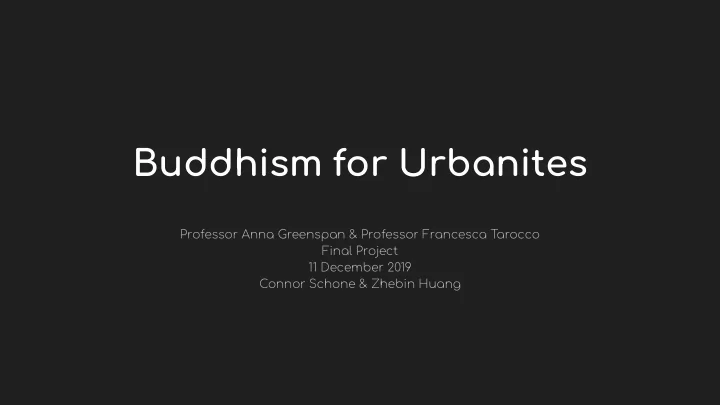

Buddhism for Urbanites Professor Anna Greenspan & Professor Francesca Tarocco Final Project 11 December 2019 Connor Schone & Zhebin Huang
Roadmap - Site: Jing’an Temple, tourist site, religious site - Research Question: How difgerent kinds of sound elevate the Jing’an Temple to a site for religious cultivation in Shanghai? - Identify difgerent sonic elements: natural sounds/religious sounds -> their significance for religious/urban cultivation - Final product: video
Field Work - Two trips to Jing’an T emple - First trip focused on mapping the space, noting scenery, and considering the overall visitor experience. - Second trip mainly concerned with finding interviewees, shooting the interview, taking pictures, and filming footages.
Argument - Jing’an T emple as a religiously significant space in Shanghai. - Can also be a place of self-cultivation for a secular audience. - T emple’s structural composition separates the interior from urban cityscape. - A new sonic ecosystem emerges inside the temple that further distinguishes the space as one for cultivation.
Sources: Natural Sounds - Significance of natural sounds: the mood it creates - Sound: immersive, afgective instrument, aura of attraction. - Senses: receptive, reproductive, simulates an environment conducive to religious practices and cultivation. - Natural Sounds - Cultivation - Following the course of the Nature is all that it takes. - Architectural design: the temple filters out the disturbing noises
Sources : Religious Sound - Significance of Chanting/Worshipping : - Non-temporal devotion, sacred ofgering to Buddha - Power vehicle to bring awareness of the Buddha - Links between the spiritual world and the secular world.
Bibliography - Chau, Adam Yuet. Religion in Contemporary China: Revitalization and Innovation . London, UNITED KINGDOM: Routledge, 2011. - Chen, Pi-yen. “Buddhist Chant, Devotional Song, and Commercial Popular Music: From Ritual to Rock Mantra.” Ethnomusicology 49, no. 2 (2005): 266–86. - ———. “The Chant of the Pure and the Music of the Popular: Conceptual Transformations in Contemporary Chinese Buddhist Chants.” Asian Music 35, no. 2 (2004): 79–97 . - Greene, Paul D., and Li Wei. “Introduction: Mindfulness and Change in Buddhist Musical Traditions.” Asian Music 35, no. 2 (2004): 1–6. - Heller , Natasha. “Buddha in a Box: The Materiality of Recitation in Contemporary Chinese Buddhism.” Material Religion 10, no. 3 (September 2014): 294–314. https://doi.org/10.2752/175183414X14101642921384. - Zhuang, Ge. “A Survey of Modern Buddhist Culture in Shanghai.” Chinese Studies in History 46, no. 3 (Spring 2013): 79–94. https://doi.org/10.2753/CSH0009-4633460305.
Video
Thank You
Recommend
More recommend